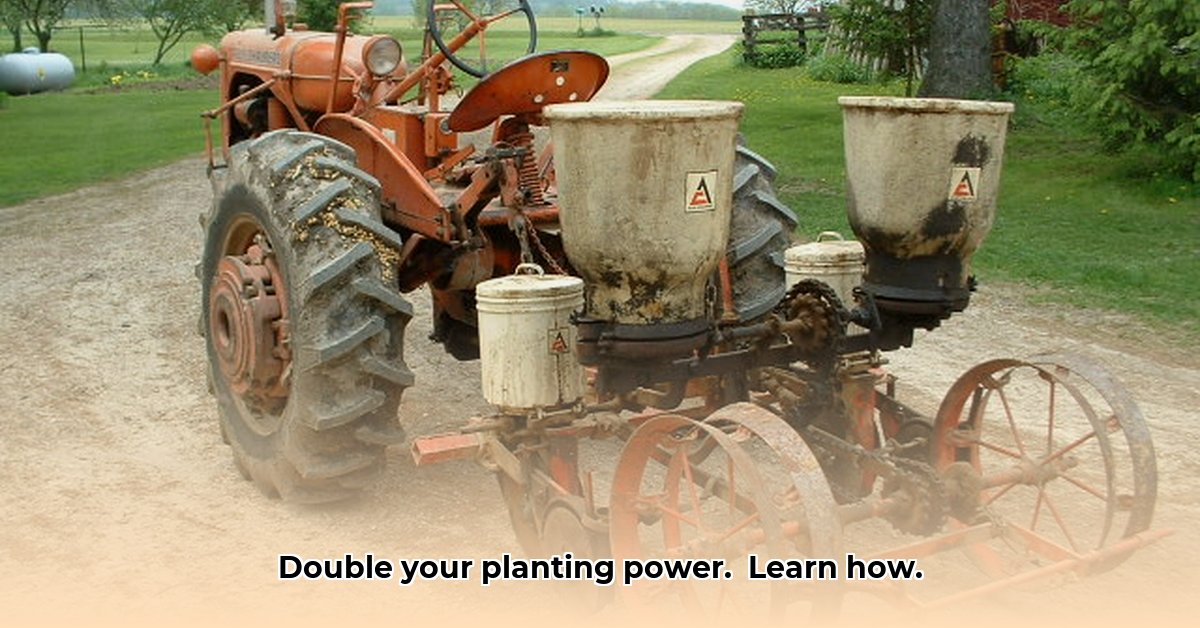
Sustainable agriculture hinges on efficiency and soil health. A two-row planter is a crucial tool for achieving both, particularly within the context of no-till farming. This guide provides a comprehensive overview, assisting you in choosing, setting up, and using a two-row planter for optimal results. For more information on tractor options, check out this helpful resource.
Choosing the Right Two-Row Planter
Selecting the ideal planter involves considering several key factors. The right choice directly impacts planting efficiency, crop yield, and long-term soil health.
Types of Two-Row Planters
Two-row planters vary in design and planting mechanisms. Single-disk openers create a precise furrow, suitable for lighter soils. Double-disk openers offer more aggressive soil penetration, ideal for heavier, compacted soils. The best option depends on your specific soil type and crop. Consider the differences carefully before making your selection.
Key Features and Specifications
Several specifications significantly affect planter performance. These include:
- Row spacing: Determines plant density and resource utilization. Wider spacing might suit larger crops, while closer spacing is suitable for smaller plants.
- Planting depth: Impacts germination and seedling establishment. Adjustable depth settings allow adaptation to varying soil conditions.
- Seed metering: Accurate seed spacing is crucial for uniform growth and yield. Precision metering systems minimize wasted seeds and ensure even crop distribution.
- Fertilizer attachment options: Allows simultaneous fertilizer application during planting, optimizing nutrient delivery and saving time.
- Hitch compatibility: Ensure seamless integration with your tractor's hitch system for safe and efficient operation.
Brand and Model Comparisons: Finding the Right Fit
While a definitive "best" planter remains subjective, several brands consistently receive positive reviews. John Deere, for instance, is known for its durable 7100 and 7200 series planters, often praised for their robust build and reliable performance. However, Kinze and Case IH also offer competitive models. Researching various brands and comparing features based on your specific needs is crucial. Look beyond brand recognition and scrutinize the specifications of individual models.
Budget and Return on Investment (ROI)
The cost of a two-row planter varies significantly depending on the brand, model, and whether you purchase new or used equipment. A used planter can represent substantial upfront savings, but consider potential future maintenance costs. Analyze the total cost of ownership, which includes purchase price, maintenance, repairs, fuel, and labor. A thorough ROI calculation will help determine if the potential yield increase and labor savings justify the investment. Will this investment improve profits and the overall sustainability of your operation?
- Data-backed rhetorical question: Does investing in a precision planter ultimately lead to a higher profit margin compared to using older, less precise methods?
Maintenance and Troubleshooting
Preventive maintenance is essential for extending the lifespan and reliability of your planter. Regular inspection, cleaning, lubrication, and prompt attention to any issues are critical. Familiarize yourself with common problems and learn basic troubleshooting techniques to minimize downtime and costly repairs.
Using a Two-Row Planter: A Step-by-Step Guide
Operating a two-row planter effectively requires a methodical approach.
- Pre-planting preparation: Inspect the planter thoroughly, ensuring all components are clean, lubricated, and in good working order. Calibrate seed meters for the chosen seed type and spacing.
- Calibration: Precise calibration is crucial for accurate seed spacing and planting depth. This step is critical for optimal germination and plant distribution. Run test rows to verify accuracy before planting the entire field.
- Hitching: Securely attach the planter to your tractor, ensuring proper hitch compatibility for safe and efficient operation.
- Planting: Operate at the recommended speed, closely monitoring soil conditions and adjusting settings as needed, to guarantee consistency in planting despite any changes in ground conditions.
- Post-planting inspection: Confirm even seed spacing and planting depth throughout the field; address any discrepancies immediately.
Best Practices for No-Till Planting
No-till farming offers numerous environmental benefits by minimizing soil disturbance. This practice improves soil structure, increases water retention, and reduces erosion. However, success depends on several factors, including appropriate seed selection, thorough soil preparation, and accurate planting depth. Ongoing research continues to refine best practices in this area. Stay informed about the latest findings to optimize your planting strategies.
Review of Popular Models: Farmer Insights
Gathering feedback from fellow farmers provides valuable insights into the performance and reliability of different planter models. While formal data might be limited, user reviews offer firsthand accounts of real-world experiences. Consider this a supplement to your own research.
Feature Comparison Table (Illustrative)
This table provides a high-level comparison; always refer to the manufacturer's specifications.
| Feature | John Deere 7100 Series (Example) | Kinze 3600 (Example) | Case IH 1200 (Example) | Notes |
|---|---|---|---|---|
| Row Spacing | Variable (e.g., 20-40 inches) | Variable (e.g., 15-30 inches) | Variable (e.g., 20-30 inches) | Check specific model specifications. |
| Seed Metering | Vacuum or Mechanical | Vacuum | Mechanical | Vacuum systems generally offer higher accuracy. |
| Fertilizer Attachment | Available | Available | Available | Check for compatibility with your system. |
| Row Unit Design | Single-Disk or Double-Disk | Double-Disk | Single-Disk | Soil conditions greatly influence selection. |
- Quantifiable fact: Research suggests that precise seed placement can increase yields by up to 15%.
Conclusion
Investing in the right two-row planter is a critical step towards maximizing efficiency and sustainability in your farming operation. By carefully considering the factors outlined in this guide, you can make an informed decision that benefits your yields, soil health, and your bottom line. Remember to consult your planter's manual for detailed instructions and safety precautions.